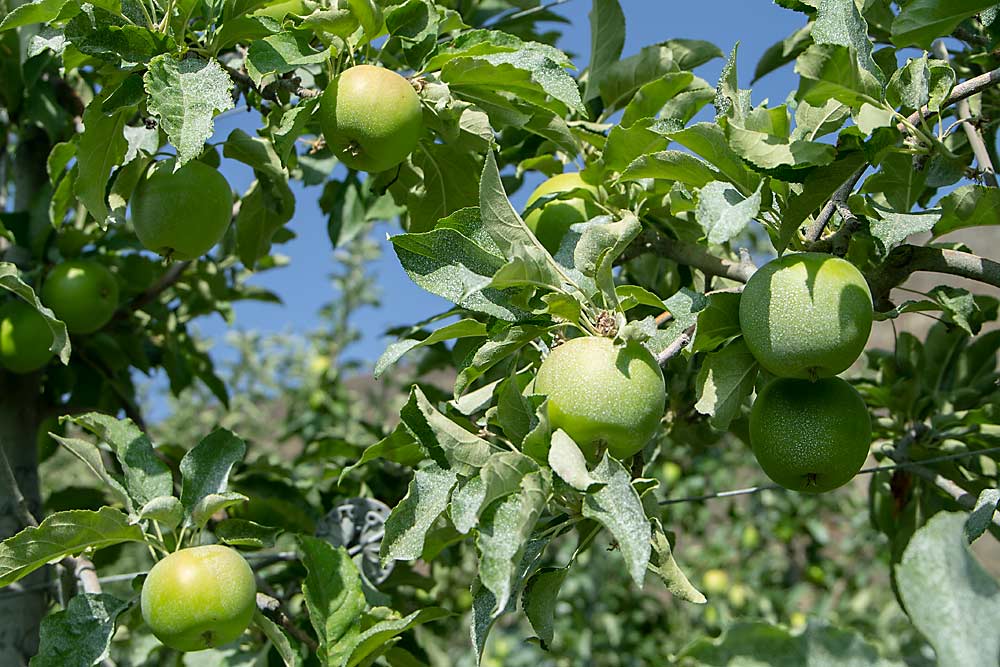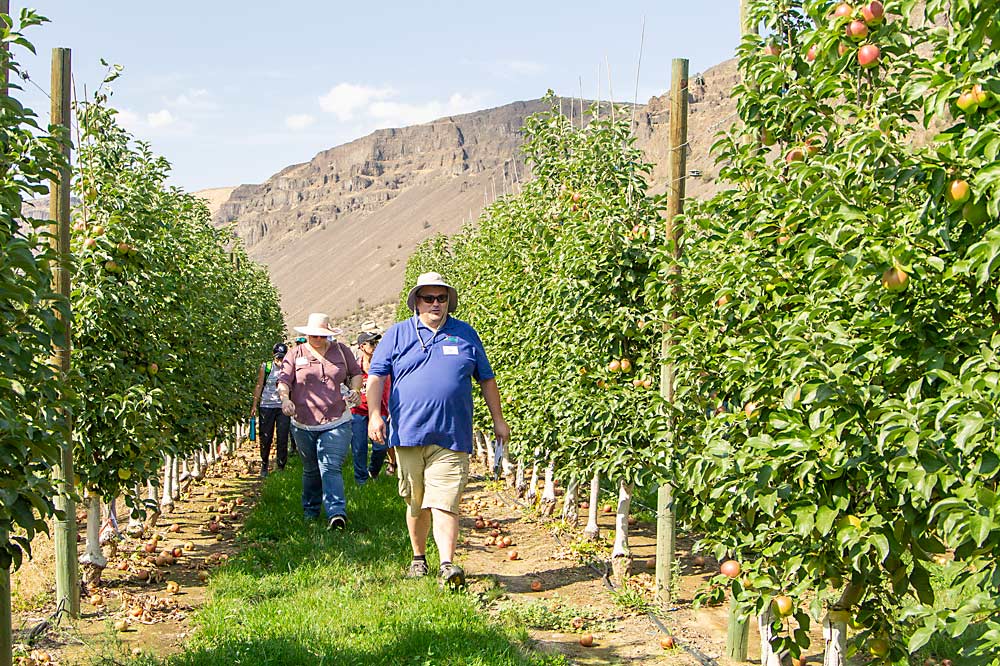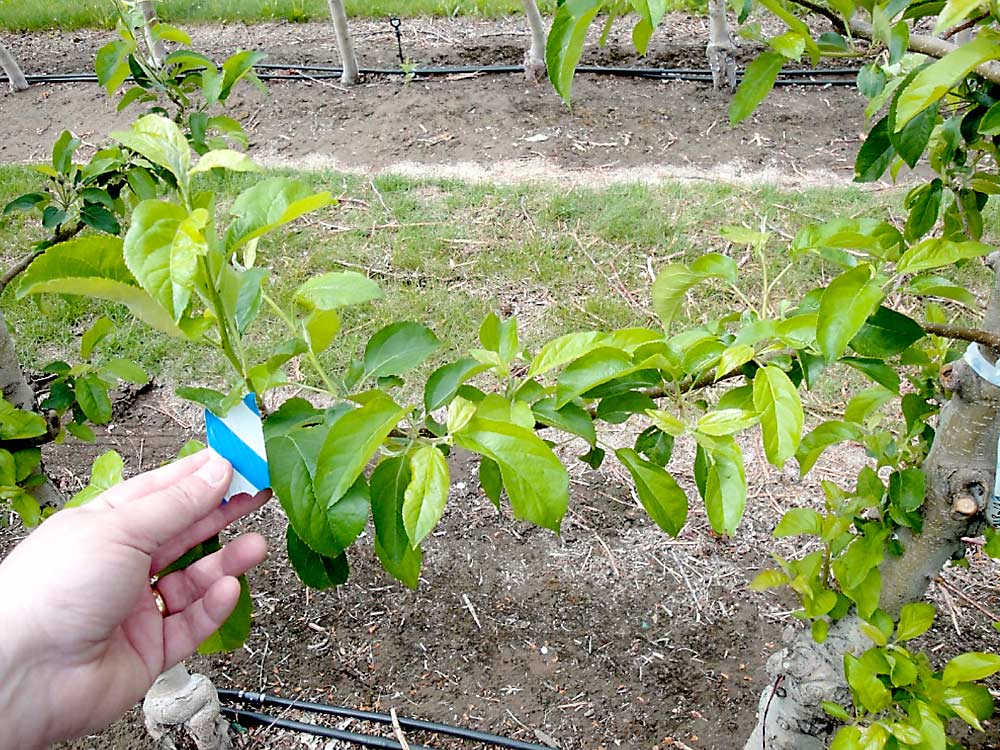
After years of crop load management trials to find the best tools for Washington apple orchards and optimize their performance, Tory Schmidt is excited to see two new strong-performing products making their way to growers.
First, a plant growth regulator that helps control biennial bearing should be available to growers this year, said Schmidt, research manager for the Washington Tree Fruit Research Commission. Second, a chemical thinner that offers consistent performance, even in Washington’s sunny regions, is steadily making its way through the registration process.
Beating biennial bearing
More than 15 years ago, Schmidt began testing plant growth regulators for their potential to reduce biennial bearing. He started by testing NAA (naphthaleneacetic acid) and ethephon to encourage bloom in off years, but he found lackluster results.
“I was seeing more consistent effects by attacking the problem from the other side, with isomers of GA to inhibit return bloom,” he said. Gibberellins, a class of plant hormone, including gibberellic acid, or GA, reduce flower bud development.
Initially, he tested GA3 products labeled for cherry growers, but despite good performance in biennial bearing-prone Honeycrisp, Fuji and Golden Delicious, the companies that made the products didn’t seem very interested in pursuing an apple label.
That changed a few years ago, when Fine Americas Inc. developed a new method of producing GA7, which is a better fit for managing return bloom, according to Drew Hubbard of Fine Americas. It will be marketed under the name Arrange.
“GA7 is far more active in reproductive physiology, tricking the tree into thinking it has more crop than it does,” Hubbard said. Plus, it has no impact on the existing crop. “Primarily, it’s going to be people applying it in the off year to reduce that biennial bearing.”

Hubbard said it performs well applied in one dose, but Schmidt found several smaller doses between petal fall and 20 mm fruitlets resulted in the best performance.
“Like a lot of PGRs, multiple doses are generally more efficacious than hitting them with a sledgehammer one time,” Schmidt said. While he got the best performance out of four doses, he said growers may find the most efficient approach is to split the dose into two applications.
Because GAs are a product of microbe fermentation, they can be registered for organic production. Schmidt thinks those growers may be the first to try the new approach.
With existing tools, “if they aren’t spot-on with their bloom thinning, they are kind of stuck,” he said.
Metamitron
“It’s a strong-enough performer that it has the potential to replace carbaryl as a thinner,” said Schmidt. He started trials with metamitron, a herbicide widely used in sugar beets, after hearing European researchers’ enthusiasm for the chemical almost a decade ago.
With carbaryl — the apple industry’s most common chemical thinner — receiving scrutiny from some retailers and regulators, researchers were eager to test out another tool, Schmidt said. He set up trials, as did University of Massachusetts horticulture professor Duane Greene and Michigan State University horticulture professor Todd Einhorn.
“Those who work with chemical thinning know you want to have a lot of tools in your toolbox,” Greene said. “Having this available (will be) very good; it will give us a whole lot more flexibility.”
Registrant Adama, an Israel-based crop protection company, already markets metamitron under the brand name Brevis in Europe, Australia, New Zealand and South America.
In the U.S., Adama is working through the Environmental Protection Agency’s registration process, said Steve Eskelsen, development leader for Adama in Washington. It’s a first-time registration, which means a longer EPA process, while in the EU and elsewhere, metamitron was already registered as a herbicide. “We would target a launch in 2023 or 2024,” based on the EPA’s process, Eskelsen said, with labels for apples and pears.

Metamitron performs well in Bartlett pears, Einhorn said, citing research he did in Oregon before joining MSU. Apples are generally trickier to thin, but he’s finding promising results with it in Michigan apple blocks, as well.
“Metamitron is like a (temporary) sledgehammer to the photosynthesis of trees,” he said, reducing photosynthesis for up to 20 days.
It works similarly to other chemical thinners, by creating a carbohydrate deficit, Schmidt said. He likened it to throwing a shade over the trees for a few days.
But, like other chemical thinners on the market, its effect is also influenced by how the weather controls photosynthesis, Greene said.
“Since it works by reducing the available carbon, the weather has to cooperate to result in a carbon deficit,” he said. “If there’s a carbon deficit, the fruit tree automatically sheds some fruit because it doesn’t have the resources.”
The label rates for the product will be different in the Eastern and Western U.S., to account for the regional differences in photosynthesis, Eskelsen said.
Now, Schmidt, Greene, Einhorn and others are working to assess the optimum rates for their climates and different varieties, so that when metamitron is available, they will be ready to tell growers how best to use it.
Greene recommends a thinning program that incorporates multiple applications of several products to minimize the risk of both over- and underthinning. Metamitron, in his experience, could fit in well between the 6 mm and 12–14 mm stages, he said.
Schmidt said that the more he has used metamitron in his trials, comparing it with carbaryl, BA (6-benzyladenine) and NAA thinning programs, the more excited he is about the potential for it to be a reliable performer.
“Even though we are late to the party in getting it registered, we’ve learned from successes and failures around the world, and that helps us to have more confidence in the end,” Schmidt said. •
—by Kate Prengaman






Leave A Comment